IF YOU SEE THE NUMBERS – STOP!
The Checking From Behind (CFB) rule was
introduced because people saw a need to protect hockey players from severe
head, neck and back injuries - the most severe consequence of these types
of injuries being death or paralysis for life.
We all recognize that checking from behind has
been part of the game of hockey since the beginning of time, but only
recently, as a result of the increasing number of serious injuries to
young hockey players, has this issue been given the attention it deserves.
The
need to enforce this rule also arose, in part, because of the lack of
respect for an opponent’s well being that is shown by players in almost
every hockey game at every level from minor hockey all the way to the
professional ranks.
Since
the introduction of the Checking From Behind penalty, the number of
serious injuries has actually decreased, so it appears to be working.
Referees
have no tolerance with anyone who is guilty of intentionally checking
another player from behind. It is one of those cowardly acts that give
hockey a bad name and the sooner we can either change the habits of
players who use this technique in the game,
or remove them from the game all together, the better.
PENALTY
OPTIONS:
Checking
from Behind has three possible calls that can be made by the Referee,
1)
Minor penalty + Game Misconduct (GM)
2)
Major penalty + Game Misconduct (GM)
3)
Match penalty
Regardless
of what call is made, any player who, in the judgment of the Referee,
checks a player from behind will be removed from that game, and, pending
the ruling of the governing bodies of that league, will possibly have to
sit out additional games under suspension. This is a very serious
infraction and the leagues are coming down hard on guilty parties.
THE
ROLE OF THE LINESMAN
Linesmen are allowed to call Game Misconduct
penalties throughout the course of a hockey game. However, since they are
not allowed to call minor penalties, they are not in a position to call a
Minor penalty plus a Game Misconduct for checking from behind. They are,
however, able to call a Major penalty plus a Game Misconduct for checking
from behind.
Many people feel that linesmen should be able
to call all Checking From Behind penalties. The debate has generated much
discussion with supporters of both positions having good arguments.
People who argue against giving linesmen this
responsibility cite the fact that linesmen are usually not as qualified or
experienced as the referee, and therefore, they may call a Checking From
Behind penalty when the referee would have called it boarding or
cross-checking. This kind of contradiction would not look very good for
the image of the game, and we’re sure there would be some very harsh
words for the linesman in between periods.
Another difficulty lies with the severe
consequences of a Check From Behind. True, it is a serious and cowardly
act, however, the automatic ejection provision has actually worked against
seeing the call made as often as it should. A referee wants to be
absolutely sure that a Check From Behind did in fact occur. Therefore, if
there is any possible doubt, he will usually award a minor penalty for
boarding, charging or crosschecking. Senior referees will take a very long
time after a borderline checking from behind infraction occurs before
giving any signal. The referee, in these cases, is trying to make certain
that an injury resulted from the infraction. He may also consult his
linesmen for their opinion on what happened.
Many referees and hockey administrators feel
that reducing the Checking From Behind to a minor and a ten-minute
misconduct would serve a better purpose and accomplish the main goal. It
would still leave the referee with the discretion of calling a major and a
game misconduct, but at least allows a strong message to be sent out
without the need for ejecting a player.
As it is now, if a linesman sees a Check from
Behind calling for a Major + Game Misconduct or a Match penalty, then he
is allowed to report this to the referee who will then either accept the
linesman’s suggestion, or make no call at all. The no call is not a
popular option if the referee wants to have the support of the linesmen in
the future, therefore, if a linesman feels the need to report a Check from
Behind to the referee it is usually felt that there must be sufficient
reason to assess the player a Major + Game Misconduct or a Match penalty.
Knowing this, however, it takes a lot for a linesman to approach the
referee with a suggestion that a player should be given a major and game
misconduct. It places the team in a deep hole and often results in a
suspension. Most linesmen will take the position that if the referee did
not call the infraction, there must have been a reason.
REFEREE’S JUDGEMENT CALL
Checking
From Behind is one of those calls that require a referee to take into
consideration a number of factors. It is not an easy call to make and
experience is generally the best teacher in this case.
1) Did the player throwing the check
mean to hit the player from behind?
Not
surprisingly, an experienced Referee will always have a gut feeling as to
whether or not a player making the check wanted to hit his opponent
directly from behind with an intent to injure. This “gut feeling’ will
have a direct impact on the call. If
the referee feels that the contact was an accident, he may lean towards
the Minor + GM for Checking From Behind.
You will also notice that many referees will substitute Checking
From Behind with “Boarding. This is often the case when the referee
feels that a player was merely hit from the side, forcing him to spin into
the boards head first. Boarding is also the call when the check was so
light that there as no possible way that any player being checked would be
injured by the force of the check into the boards. From the point of view
of a parent, or other players, the force of impact may sound much worse
than it actually was. A referee must be very observant when it appears as
if there will be contact from behind. He must anticipate the contact and
be ready to make a tough judgment call.
2) Did the hit occur on the side of the shoulder and cause the
player to spin into the boards as though he was checked from behind?
Quite
often a player will hit an opponent on the side of the shoulder and this
will send the player into the boards awkwardly. Coaches and fans dispute
these hits the most, but the key for the referee is that the check never
actually occurred from behind. It was the way that the player being hit
went into the boards that made it look as though he was checked from
behind. If in the referee’s opinion, the player receiving the check was
hit legally and it was the way that he went into the boards that made it
look like a check from behind, the Referee will either not call a penalty
or he may assess a minor for boarding, if he feels that the player
throwing the check wanted to violently throw his opponent into the boards.
|
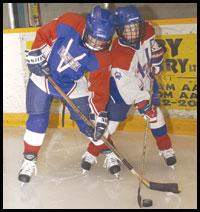
|
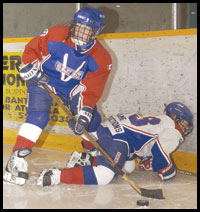
|
| In the above example, it appears as if
the blue player hit the white player on the shoulder, causing him
to go head first into the boards. This would not be called
checking from behind since the check never really took place from
behind, but rather from the side. |
3) Did the player being hit turn at the last second? This is still
a penalty for Checking from Behind, but it may change a Major to a Minor
penalty.
Remember
that if a player about to be checked turns at the last second and is hit
from behind, then the player throwing the check should still be assessed a
penalty for Checking from Behind. This is very much like the rule of thumb
in driving an automobile. In all rear end collisions, the driver of the
car in the back is usually always charged because it is expected that he
will keep a safe distance from the car in front to stop suddenly.
Referees
soon become well aware of players who always turn their backs when they
are about to be hit, especially after the Ref has seen the player over a
few games. These players will rarely suck a player into a CFB penalty once
the Referee is familiar with their tendencies. Referees consider players
such as these as merely
trying to show up the referee and make his job that much more difficult.
This does not generate much respect from the officials.
4) Was the player throwing the check in
motion or standing still?
During
a game, you will sometimes see a player who is skating backwards run into
an opposing player who is standing still. The player standing still
usually puts out his stick in a crosschecking motion, causing the player
skating backwards to fall to the ice with his head snapping back. This is
not a check from behind because the player standing still did not check
the player. He was just standing his ground. It looks bad from the stands,
but it should not be called a checking from behind.
Another
common situation occurs when two players are standing in front of the net
battling for position. The defenseman will usually throw a few crosschecks
to the back of the opposing player, which will at times cause the player
to fall to the ice. This is not a check from behind because the player
throwing the crosscheck was not in motion, however he can still receive a
penalty for crosschecking. The action in front of a net can be quite
intense. It is sometimes called “no man’s land’, or “suicide
alley” because of the abuse that forwards often take from defensemen
trying to clear the front of the net.
The
key to look for in the above situations is “who was in motion”? If the
person doing the striking was standing still, the referee will not usually
call a penalty for Checking From Behind. Parents and coaches often react
emotionally whenever they see a player falling down in a manner consistent
with being hit from behind. However, imagine two automobiles sitting at an
intersection. If the car in front suddenly lurches in reverse, striking
the car behind. The driver of the car behind will not be charged, even
though when the police come to check things out, his car will seem as if
it did the hitting.
|
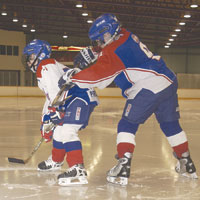
|
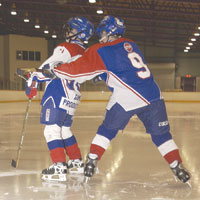
|
|
In these two
photos, you see what commonly happens in front of the net. Both the
Forward (white) and the Defence (blue) are battling for postion. The
defenceman throws a cross-check into the forward’s lower back.
This is not a Check From Behind because the Defenceman was not in
motion. |
5) Was there unintentional contact made to the back of a player
while players were battling for the puck?
This
happens quite often throughout a game where you have two aggressive
players are battling for the puck along the boards. Usually the forward is
trying to shield the puck from the defender by using his body to keep the
puck along boards. His body is about
3 or 4 feet away from the puck to keep it out of reach of
the defender. The defender will sometimes make contact with the
back of the forward as he is trying to get the puck and this contact may
send the forward into the boards head first. This is a judgment call for
the referee to make. Since the defending player is usually not in motion,
it is tough to call a checking from behind penalty, so referees will
either call nothing and let play continue or they will assess the
defending player with a boarding penalty just to say that they made a call
when a player went head first into the boards.
A
boarding call in this case is an excellent game management tool that
allows the referee to calm down the team whose player just went head first
into the boards, and it also calms the defending player’s team that is
happy that their player did not get kicked out of the game. The time
between blowing the whistle and signaling the call is also an opportunity
to calm down the crowd.
Senior
referees will usually take their time making the final signal. You will
often see the referee go over to the timekeeper’s area, watch the player
sit down in the penalty box, and then speak to his linesmen. There is a
hush over the arena as the offending player’s team waits anxiously to
see if there is going to be an ejection. The victim’s team, if the
victim happens not to have been hurt, is already satisfied with a penalty,
and they now await the verdict. The reason this results in a calming
effect on both sides is that the referee will be letting everyone in the
arena know how he will be calling these infractions for the remainder of
the game. At times, when the referee finally signals a minor for boarding,
there is relief and a sense of gratitude which forces the players to calm
down and play more sensibly. If the player is ejected for Checking From
Behind, both teams realize that any more nonsense will result in a similar
call since the referee will be indicating that he is fed up with this kind
of play. In either case, the length of time between the infraction and the
signal is a buffer zone that is one of the most effective methods of game
management available to a referee.
6) Was the player who received the check
able to protect himself?
This
is a critical factor in determining if a minor, major or match penalty
will be assessed. If the player being checked from behind can get his arms
up in a manner that will help slow himself down, or protect his head from
hitting the boards first, then you will usually see a minor penalty called
instead of a major.
If
a player goes into the boards or net and is unable to get his arms up
above his head, and the head makes contact with the boards or net first,
then the referee will usually go to a Major or Match penalty. The
mere fact that the player was unable to protect himself increases
the chances of injury and thus a more severe penalty will most likely be
assessed. When you are waiting for the signal to be made by the referee,
keep in mind this protection factor. It is perhaps the most critical
element in the call.
|
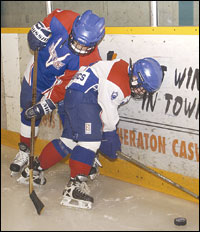
|
The above photo
relates to point #6. This player being checked from behind was
unable to get his arms up against the boards &/or glass in order
to protect his head &/or shoulder from contacting the boards
first. When a check from behind like this one occurs and an injury
occurs, a referee may lean towards a more severe penalty such as a
Match penalty instead of the Major penalty plus a Game Misconduct. |
7) Was the check in open ice or was it into the boards or net?
An
open ice check from behind is not quite as serious as a check into the
boards where the player comes to a sudden stop. For example, an open ice
check from behind will send the player sliding down the ice and will
usually not result in an injury. The injury that is most common from an
open ice check from behind is to the neck, and is very similar to whiplash
injuries from car accidents.
On
the other hand, if you see a player going into the boards or net without
the opportunity to protect himself, you will usually see a major and game
misconduct penalty called. This is because the neck and spine are more
susceptible to a break when the top of the head hits the boards. The solid
contact stops the head while the rest of the body continues its momentum,
thus squeezing the vertebrae and resulting in a break if the impact was
hard enough.
So,
even though the act may clearly be an intentional check from behind,
the one in open ice may only give the team a 2 minute power play
while the one near the boards may give the team a five minute opportunity.
In Canada, both penalties will result in a game ejection.
8) Did the players neck snap back or was
it a light hit? The position of the head is an important element.
If
the player’s head snapped back after the check from behind then the
referee is more likely to assess a CFB penalty because the player’s neck
snapping back shows that there was some excessive force being used.
When
a player goes into the boards headfirst, the referee will look to see if
the top of the head, the players face, or the back or side of the head hit
the boards first. Obviously hitting the top of the head, first creates a
greater opportunity for injury to occur. Regardless of the position
of the head going into the boards, a checking from behind penalty should
be called. The position of the head and the speed of the player going into
the boards will determine what the Referee assesses. The faster the
contact, and the closer to the top of the head at impact, the greater the
chance that the penalty will be a Major or Match penalty.
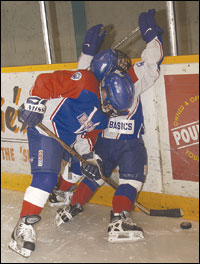 |
When a player is
plastered up against the boards causing his head to snap back and
his back to bend in a "U" shape, there is a good chance
that a penalty may be assessed if the official was able to see the
check. |
9) Did the player making the check try to
catch or hold the player up as he was making the check?
Most
coaches teach their players that if they are about to hit a player from
behind, they should try to grab hold of the player in an attempt to slow
the person down as he goes into the boards. The reason why this is a good
move is because if a referee sees some kind of attempt to try to stop the
player from going into the boards head first, he is more likely to give a
lighter penalty, if he assesses one at all. If a referee sees that a
player did not mean to drive a player from behind into the boards, or in
the open ice then, there is less chance that the player will receive a
penalty.
Checking
From Behind penalties are assessed to players who intentionally drive
their opponents into the boards. This
shows a lack of respect for an opponent and thus officials will have very
little sympathy for players who behave in this reckless manner. Most
referees consider a Check from Behind to be a cowardly act, and since
referees most often played the game themselves, they know what it is like
to be hit from behind.
If
you do hit a player from behind, and if you try to catch the player, you
are showing a bit of respect and demonstrating that you didn’t intend to
hit the person from behind. You may still get a penalty, but the game
report will record what you did after the hit and it will have an impact
on how long you are suspended.
10) Did the player throw himself into the
boards trying to draw a penalty?
Parents,
coaches, players, and referees have all seen players who, after being
touched in the back, throw themselves into the boards. This sounds crazy
but there are players who will do anything to try and get a power play,
even if it means putting your neck on the line (no pun intended!).
If
a referee suspects this, don’t expect a penalty call against the person
doing the hitting, especially if the player being tapped makes a mockery
of the game by throwing himself into the boards. Parents don’t see the
hit as clearly as the referee, so this type of action has the effect of
getting the crowd riled up. That being the case, don’t be surprised if
the referee assesses a minor penalty for
“Unsportsmanlike Conduct” to the player throwing himself into
the boards.
Players
must get it though their heads that referees do not like being “shown
up”. The job is difficult enough without having to put up with players
who are out to make the referee look bad, or who will go back to the bench
laughing at the referee after a successful dive. Players should also
realize that referees actually speak to each other. Reputations will
spread throughout the league and it will soon become like the “boy who
cried wolf”. Players who are known to “dive” or “fake hits” may
one day actually be hit seriously and the referees will ignore the action.
Respect is a two-way street. The sooner players realize this, the better.
11) Was the check in the middle of the
back or on the side of the back?
A
key factor that will determine if a penalty for checking from behind is
called is whether or not the player was checked in the middle of the back
or towards the outer edges of the back, away from direct contact with the
spine.
The
closer a player is checked near the sides of the body, even though the hit
was in the back region, the less chance the player will receive a checking
from behind penalty. This is because a Referee does not want to kick a
player out of the game unless he is absolutely sure that the player
committing the infraction deserved a game misconduct. Once again, because
the penalty is so severe, it is often downgraded to something of a less
serious nature.
12) The player is injured so why wasn’t
a Major + Game Misconduct called?
You
must remember that even though the rule states that as soon as a player is
injured the player causing the injury must receive a Major plus a Game
Misconduct, this may not happen because of the point made in #11 above.
If
a Referee is unsure as to whether or not a player is actually hurt, or if
the Referee feels that the player will not miss a shift, then the Referee
may choose to sway away from the “Black & White” rule book and not
assess the Major + GM, but may go to the Minor penalty plus a Game
Misconduct.
The
key factor with regards to if a Referee will assess a minor, major or
match penalty is the severity of the hit, not the actual injury (if any)
that may result. Remember,
you may also see a player receive a Major + GM for Checking From Behind
even though the player that was checked jumps up immediately and continues
into the play. Remember that it is the
severity, force, intent and location on the back that results in Checking
From Behind penalties being assessed.
SUMMARY
Now that you understand
everything a Referee must consider when deciding whether or not to assess
a checking from behind penalty, and then whether to make it a Minor + GM,
Major + GM, or a Match penalty, you can see that it is not an easy call to
make, especially when referees don’t have the luxury of using various
video angles and an unlimited amount of time to analyze a possible check
from behind.
Referees have a split second to factor in all
the above points and make their decision based on what they are able to
see from their specific position on the ice. Sometimes the referee may be
screened by other players, and may not be able to see the entire
infraction.
Referees
still consider Checking From Behind to be a very serious infraction. They
will deal harshly and without hesitation when the action calls for such
penalty. However, there are so many things to consider, not the least of
which is intent, that it may not be called enough as far as parents and
coaches are concerned. There is no doubt, however, that the number of
Checking From Behind incidents has been drastically reduced since the
introduction of the penalty.
OTHER LEAGUES
This is not to add confusion to the matter,
but you must also keep in mind that Minor Hockey has different rules from
Amateur or Professional Hockey!
In the OHL (Canadian Hockey League – Major
Junior A) and other upper leagues this rule is slightly modified because
these leagues are no longer at the minor hockey level - they are now in
the amateur/professional category. The minor hockey associations try to
protect their participants to a greater extent and thus they create
stricter penalties to provide this protection.
As for the OHL, the biggest difference is that
the player is not ejected from the game when he receives a minor penalty
for checking from behind. In addition, the referee has another option
whereby he can issue a double minor penalty for a more sever check from
behind, but sill leave the player in the game.
As a result, you may see a higher incidence of
checking from behind penalties being called in the OHL than in minor
hockey. It doesn’t mean that players are committing this infraction any
less at the minor hockey level, it is just that instead of identifying an
infraction as a checking from behind, referees are more likely to call
boarding, charging or cross-checking if they feel it was without intent or
was not of a serious nature. The infractions are similar, but the
consequences are different.
